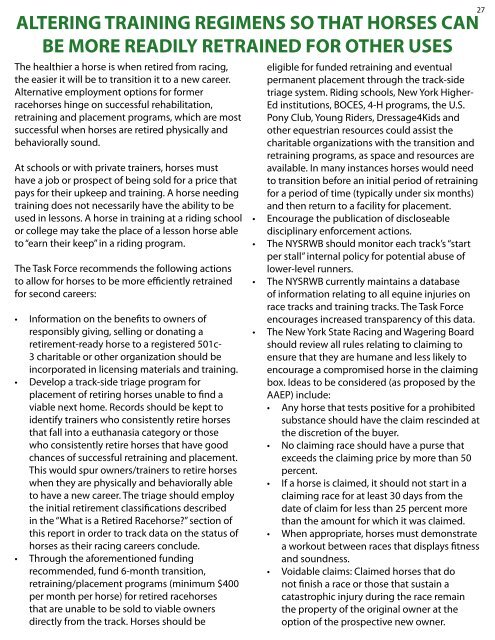Retired Racehorses
tfrr_reportandappendicesfinal
tfrr_reportandappendicesfinal
- No tags were found...
You also want an ePaper? Increase the reach of your titles
YUMPU automatically turns print PDFs into web optimized ePapers that Google loves.
27<br />
ALTERING TRAINING REGIMENS SO THAT HORSES CAN<br />
BE MORE READILY RETRAINED FOR OTHER USES<br />
The healthier a horse is when retired from racing,<br />
the easier it will be to transition it to a new career.<br />
Alternative employment options for former<br />
racehorses hinge on successful rehabilitation,<br />
retraining and placement programs, which are most<br />
successful when horses are retired physically and<br />
behaviorally sound.<br />
At schools or with private trainers, horses must<br />
have a job or prospect of being sold for a price that<br />
pays for their upkeep and training. A horse needing<br />
training does not necessarily have the ability to be<br />
used in lessons. A horse in training at a riding school<br />
or college may take the place of a lesson horse able<br />
to “earn their keep” in a riding program.<br />
The Task Force recommends the following actions<br />
to allow for horses to be more efficiently retrained<br />
for second careers:<br />
• Information on the benefits to owners of<br />
responsibly giving, selling or donating a<br />
retirement-ready horse to a registered 501c-<br />
3 charitable or other organization should be<br />
incorporated in licensing materials and training.<br />
• Develop a track-side triage program for<br />
placement of retiring horses unable to find a<br />
viable next home. Records should be kept to<br />
identify trainers who consistently retire horses<br />
that fall into a euthanasia category or those<br />
who consistently retire horses that have good<br />
chances of successful retraining and placement.<br />
This would spur owners/trainers to retire horses<br />
when they are physically and behaviorally able<br />
to have a new career. The triage should employ<br />
the initial retirement classifications described<br />
in the “What is a <strong>Retired</strong> Racehorse?” section of<br />
this report in order to track data on the status of<br />
horses as their racing careers conclude.<br />
• Through the aforementioned funding<br />
recommended, fund 6-month transition,<br />
retraining/placement programs (minimum $400<br />
per month per horse) for retired racehorses<br />
that are unable to be sold to viable owners<br />
directly from the track. Horses should be<br />
eligible for funded retraining and eventual<br />
permanent placement through the track-side<br />
triage system. Riding schools, New York Higher-<br />
Ed institutions, BOCES, 4-H programs, the U.S.<br />
Pony Club, Young Riders, Dressage4Kids and<br />
other equestrian resources could assist the<br />
charitable organizations with the transition and<br />
retraining programs, as space and resources are<br />
available. In many instances horses would need<br />
to transition before an initial period of retraining<br />
for a period of time (typically under six months)<br />
and then return to a facility for placement.<br />
• Encourage the publication of discloseable<br />
disciplinary enforcement actions.<br />
• The NYSRWB should monitor each track’s “start<br />
per stall” internal policy for potential abuse of<br />
lower-level runners.<br />
• The NYSRWB currently maintains a database<br />
of information relating to all equine injuries on<br />
race tracks and training tracks. The Task Force<br />
encourages increased transparency of this data.<br />
• The New York State Racing and Wagering Board<br />
should review all rules relating to claiming to<br />
ensure that they are humane and less likely to<br />
encourage a compromised horse in the claiming<br />
box. Ideas to be considered (as proposed by the<br />
AAEP) include:<br />
• Any horse that tests positive for a prohibited<br />
substance should have the claim rescinded at<br />
the discretion of the buyer.<br />
• No claiming race should have a purse that<br />
exceeds the claiming price by more than 50<br />
percent.<br />
• If a horse is claimed, it should not start in a<br />
claiming race for at least 30 days from the<br />
date of claim for less than 25 percent more<br />
than the amount for which it was claimed.<br />
• When appropriate, horses must demonstrate<br />
a workout between races that displays fitness<br />
and soundness.<br />
• Voidable claims: Claimed horses that do<br />
not finish a race or those that sustain a<br />
catastrophic injury during the race remain<br />
the property of the original owner at the<br />
option of the prospective new owner.


